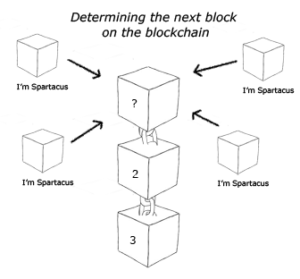
When I first came across PoW, thoughts of the dynamic duo batman and robin came to mind. Then “Prisoner of War”. Maybe Proof of Weapons (of Mass Destruction)? It actually stands for Proof of Work and to understand it, let’s take a step back.
Miners process transactions on the blockchain. What this really means is that miners collect all the transactions into a block and then validate and verify the information based on preset rules. Once all the rules are satisfied, miners then proposes that their particular collection of transactions should be accepted as the next block on the blockchain. Thousands of miners around the world do this, so whose block should be accepted?

This is where Proof of Work comes in. All the miners need to “prove they did some work”. They don’t have to prove they did the most work or the best quality work, just that some work was done.
Proof of Work is designed to be computationally hard to perform but easy to validate and also random in nature. There are lots of in-depth articles on the inner workings of PoW but let’s draw an analogy.
Imagine having 2 dice. The chances of obtain a total of less than 10 when the results of the 2 dice are added together is relatively easy. A 6 and 3, or 4 and 4 etc.

10 is called the target. If the target is met very quickly, the target can be lowered to say 3. This would mean the only possible option is rolling a 1 and 1. Thus you would have to roll the dice more times and do “more work” to eventually meet this target.
The target is self adjusting. That is, it has a bit of intelligence. In the bitcoin blockchain, the target is re-adjusted every 2 weeks so that on average, the target is achieved every 10 minutes.
In the blockchain world, the word difficulty is used a lot. If the target decreases, this means the difficulty increases and vice versa.

In the above chart, the difficulty (red line) is self adjusting, dropping when the hash rate drops and increases when the hash rate increases. Albeit with a 3.5 day delay instead of 2 wks like bitcoin.
Now imagine having 10,000 dice and having to meet a target of 10,001. ie all 10,000 dice showing 1. That could take quite a while. The first miner to hit this target could then prove to all the other miners, maybe by way of a video recording and uploading it to YouTube, have the block accepted to the blockchain and get paid a reward. For bitcoins it’s a reward of 25 BTC at the current time of writing.
Of course in reality there are no YouTube videos. What is used is a hash function where the hash of the block header needs to have a certain number of leading zeros. The more zeros, the harder it is to solve. However, once solved, it is very easy to verify that the answer is correct.
The reward is important because that is what incentivises the miners. The miners are actually expending real world energy in the form of electricity to run the computers to do these calculations.
Conclusion
Proof of Work is a mechanism that allows the peer to peer distributed blockchain network to determine which block will be next added to the blockchain. It is a random process where each miner needs to solve a particular equation by achieving a result that is lower than the self adjusting target. The target value is set by the blockchain designer who determines how long it should take for each block to be put on the blockchain. 10 minutes for bitcoin, 2.5 minutes for litecoin and 12 seconds for Ethereum.

2 thoughts on “Going POW on the Blockchain”